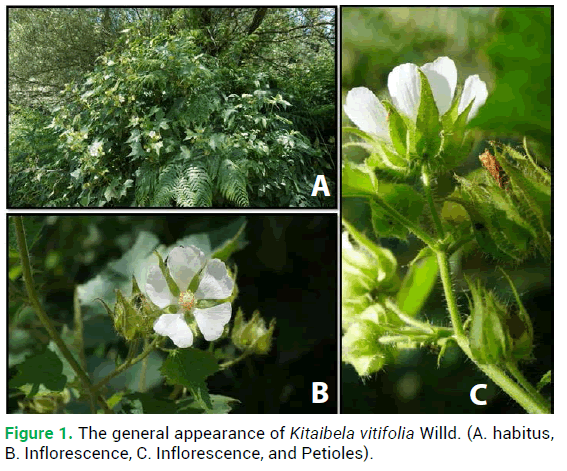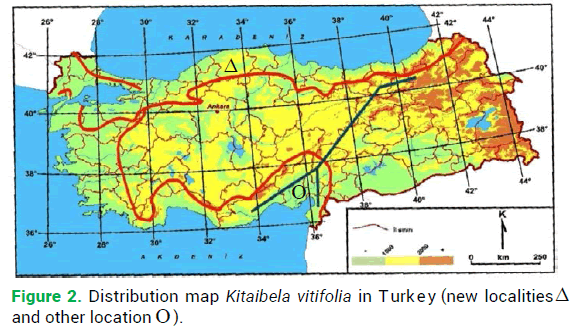Research Article - Modern Phytomorphology ( 2020) Volume 14, Issue 1
Distribution patterns of rare Kitaibela vitifolia Willd in Turkey: Taxonomy, chorology, and conservation
Tunçkol B1*, Yaşayacak H2 and Aksoy N32Küre Mountains National Park Directorate, Bartın 1. Ring Road Avenue Bartın Governor’s Office 3. Floor, 74100 Bartın, Turkey
3Düzce University, Faculty of Forestry & DUOF Herbaria Konuralp, 81620 Düzce, Turkey
Tunçkol B, Bartın University Ulus Vocational School Department of Forestry and Forest Products Program, 74100 Bartın, Turkey, Tel: 9003785011000, Email: bilgetunckol@gmail.com
Received: 18-Nov-2019 Accepted: 17-Dec-2019 Published: 01-Jan-2020, DOI: 10.5281/zenodo.4449914
Abstract
Kitaibela vitifolia is a locally rare species known from only one locality in southern Turkey. After the new discovery of Kitaibela vitifolia, it has been recorded from a new locality in Kastamonu province in northern Turkey. Brief history, morphology, chorology, habitat, and ecology of this rare species have been discussed in this research. The conservation status of Kitaibela vitifolia is also reviewed based on the present distribution data.
Keywords
Kitaibela vitifolia, Taxonomy, Chorology, Anatolian diagonal, Turkey
Introduction
There are only 2 species of Kitaibela one of them was Kitaibela vitifolia that was named to honor Paul Kitaibel a famous Hungarian Botanist and described by him, in 1800 in Eastern Slovenia (Croatia) and another from the South West Taurus mountains in Turkey, Kitaibela balansae, which was described by the Swiss Botanist Boissier (Belder 1993; Cullen 1967; Davis 1971; Groom 2010).
These two species of Kitaibela genera belong to the Malvaceae family which has totally 1500 species. In the flora of Turkey there was just one species of this genus: Kitaibela balansae. Then, Kitaibela vitifolia species was collected by Tugay and et all. The natural habitat of Kitaibela balansae is Turkey, Syria, and Lebanon. However, Kitaibela vitifolia is naturally distributed in Yugoslavia, Kosova, Bosnia Herzegovina, Montenegro, Croatia, Macedonia, Serbia, and Albania it has been cultivated in Hungary and Romania. Kitaibela vitifolia is a rare species, often has been used as an ornamental plant and it is mostly under threat. After the plant samples belong to Kitaibela vitifolia were collected from Mount Amonos by Tugay et al. for the first time in 2014, they were collected from the Kastamonu section of Küre Mountains in the personal field investigations in 2019. This article reports an additional new locality and population to its distribution in Turkey. In this study, morphology, chorology, ecology, habitat, conservation status and distribution of this species are discussed (Cullen 1967; Davis 1971; Barina et al. 2013; Ertuğrul et al. 2016; Özhatay et al. 2017; Tomović et al. 2007).
Materials and Methods
This study was carried out by personal field investigation, the examination of the specimens kept in the Herbaria Edinburgh, and extensive analysis of literature. The identification of the species is based on personal observations of herbarium materials and living plants.
The Kitaibela vitifolia plant sample was collected from the core zone of the Kastamonu section of Küre Mountains National Park in 2019. Then, it was determined that these collected samples are different from the Kitaibela balansae, and they were identified according to Flora of Europea and described as Kitaibela vitifolia.
Results and Discussion
Basionym
Malope vitifolia (Willd.) Hegi
Description
Large perennial herbs. Shrub like habit Stem robust, up to 195 cm, and sparingly branched. Stem petioles and inflorescence with hispid white hairs. Leaves glabrescent and long petiolate. Petioles up to 13 cm. Lamina up to 17 cm, rhombic to suborbicular cordate, with 5-7 triangular dentate lobes. The inflorescence is a cyme with 1-4 flowers born in mid-summer, in a leaf axis. Epicalyx segments 6-9 slightly connate at the base. The segment is ovate, acuminate slightly longer and wider than the sepals. White petals 24 × 20 mm obdeltate cuneate, entire or slightly retuse. Stigmas filiform and laterally. Schizocarp fruit, mericarp dark brown hairy and dehiscent (Fig. 1).

Figure 1. The general appearance of Kitaibela vitifolia Willd. (A. habitus, B. Inflorescence, C. Inflorescence, and Petioles).
Key to closely related Kitaibela vitifolia
1. Leaves 5-7 lobed. Cymes 1-4 flowers. Petals white… ……K. vitifolia
1. Leaves +/- triangular. Cymes solitary. Petals red… ………K. balansae
Examined specimens
Examined specimens of Kitaibela samples were collected from the western part of The Black Sea Region A4: Kastamonu; Küre Mountains National Park (B. Tunçkol 4501, DUOF 1941).
Distribution
Turkey (Western Black Sea Region), A4 Kastamonu, Küre Mountain National Park, 100-1100 m, near the stream, grassland. Some parts of Europe Yugoslavia, Kosovo, Bosna and Herzegovina, Montenegro, Croatia, Macedonia, Serbia and Albania (Cullen 1967; Davis 1971; Barina et al. 2013; Ertuğrul et al. 2016; Tomović et al. 2007), (Fig. 2).

Figure 2. Distribution map Kitaibela vitifolia in Turkey (new localities △ and other location Ο).
Taxonomic treatment
This species determination point is the core zone of the Kastamonu section of Küre Mountains National Park, so it’s very pleasing for this species continuity.
Habitat and ecology
In Kastamonu, it occurs at elevations between 1000- 1100 m. It grows with Fagus orientalis Lipsky, Buxus sempervirens L., Carpinus betulus L., Salix alba L., Lonicera caucasica Pall., Alnus glutinosa (L.) Gaertn., Pteridium aquilinum (L.) Kuhn, Pulicaria dysenterica (L.) Bernh., Cirsium canum (L.) All., Inula helenium L. subsp. orgyalis (Boiss.) Grierson, Galeopsis bifida Boenn., Senecio aquaticus Hill subsp. erraticus (Bertol.) V.A.Matthews and Galega officinalis L.
It was collected from the clearing of the pine forest in a narrow area in Mount Amanos. However, in the Kastamonu region, it was collected from damp grassland near the brook. In addition to that, in Europe it was found in damp thickets and grassland.
Conclusion/Chorology of the Species and Origin of the Turkish Population
The Irano Turanian flora region is divided into two by Anatolian Diagonal that begins from Gümüşhane- Bayburt and bifurcates through Anti Taurus in the southwest (Davis, Harper & Hedge, 1971). There are 550 taxa in this region and it has been determined that almost 135 of it does not distribute on the west of diagonal and 228 of it not distribute on the east. In the ice age, plants that have Euro Siberian characteristics in North Anatolia (Fagus orientalis Lipsky, Buxus sempervirens L., Carpinus betulus L., Ostrya carpinifolia Scop., Taxus baccata L., Ilex colchica Pojark., Corylus avellana L., Corylus colurna L., Lonicera caucasica Pallas ssp. orientalis (Lam.) Chamb et Long, Sambucus ebulus L.), moved to South Anatolia because of Anatolian Diagonal. So, especially in the region of Mount Amanos and Gavur Mountains, it is seen mixed forests under the dominance of Fagus orientalis L. that belongs to the sub-Euxine part of Euro Siberian floristic region. The distribution of Kitaibela vitifolia in Küre Mountains is connected with its distribution in Middle West Europe and Balkans and it is understood that origin and characteristics of this plant belong to sub-Euxine part of Euro-Siberian floristic region. Kitaibela vitifolia, collected by Tugay et al. from Osmaniye in 2014 is not a plant that has Mediterranean origin. On the contrary it is originated in Euro Siberian as it is mentioned above, and it was found in Osmaniye due to Anatolian Diagonal (Avcı 1996; Ekim & Güner 1986; Webb 1976.).
It was observed differences when the samples of Kitaibela vitifolia collected from the Kastamonu region compared with the samples distributed in Europe (RBGE, Edinburgh). There are especially some differences on the leaf size and pubescence characteristics of the samples. Kitaibela vitifolia can probably be discovered in the different regions of Turkey with extensive field studies.
This species that distributes on Kastamonu and Mount Amanos, has a few individuals in Küre Mountains National Park. It is pleasing that this species distributes in Core Zone and there is no construction in its surroundings. Yet it is very important that it should be taken under protection by General Directorate for National Parks for its continuity. It has been the subject of various studies, and it deserves to be more widely grown. So, when it’s considered its narrow distribution in Turkey and the importance of it in Europe, it is suggested that its conservation status should be Vulnerable (VU).
Acknowledgments
This study is supported by Bartın University (BAP), Project number: 2019-Fen-B-005.d.
References
- Belder J.D. 1993. Mysterious Kitaibelas. Karaca Arbor Mag. 2: 29-32.
- Cullen J., Davis P.H., Coode M.J.E. 1967. Flora of Turkey and the East Aegean Islands, Edinburg. Edinburgh: University Press. 2: 401-420. https://trove.nla.gov.au/work/10616320?selectedversion=NBD650685
- Davis P.H., Harper P.C., Hedge I.C. 1971. Distribution patterns in Anatolia with particular reference to endemism. Food and Agri Org UN. 15 -27. http://agris.fao.org/agris-search/search.do?recordID=US201302308461
- Barina Z., Rakaj M., Pifkó D. 2013. Contributions to the flora of Albania, 4. Willdenowia. 43: 165-184. http://dx.doi.org/10.3372/wi.43.43119
- Ertuğrul K., Tugay O., Aslan S., Ulukuş D. 2016. A new record for the flora of Turkey: Kitaibela vitifolia (Malvaceae). XV. Optima Meeting Abstract Book. 132. https://www.researchgate.net/publication/309742568_A_new_record_for_the_flora_of_Turkey_Kitaibela_vitifolia_Malvaceae
- Özhatay N., Kültür Ş., Gürdal B. 2017. Check-list of additional taxa to the supplement flora of Turkey VIII. Istanbul J Pharm. 47: 30-44. https://cdn.istanbul.edu.tr/file/1CD58DF90A/BEE07CBD77F94355AB2F2FE1D9BECCE6?doi=10.5152/IstanbulJPharm.2017.006
- Tomović G., Vukojičić S., Niketić M., Lakušić D. 2007. New chronological data on some threatened and rare plants in Serbia. Arch Biol Sci Belgrade. 59: 63-73. https://pdfs.semanticscholar.org/8688/4ca5db11f88ca44148e110c336e5b1dc6d84.pdf
- Avcı M. 1996. The floristic regions of Turkey and a geographical approach for Anatolian diagonal, Review of the Department of Geography, University of Istanbul, Istanbul. 3: 59-91. https://mafiadoc.com/the-floristic-regions-of-turkey-and-a-_5adb729d7f8b9a7d438b459d.html
- Ekim T., Güner A. 1986. The Anatolian Diagonal: fact or fiction? Proceed Royal Soc Edinburgh, Sec B: Biol Sci. 89: 69-77. https://www.cambridge.org/core/journals/proceedings-of-the-royal-society-of-edinburgh-section-b-biological-sciences/article/anatolian-diagonal-fact-or-fiction/AF650CE7DED984535232C48B37B20D6C#fndtn-information
- Webb D.A. 1976. Flora Europaea. Cambridge Univ Press, Cambridge. 2: 248-256.
- Groom Q. 2010. Manual of the Alien Plants of Belgium. Kitaibela. http://alienplantsbelgium.be/content/kitaibela